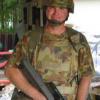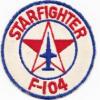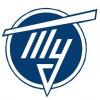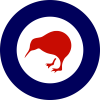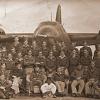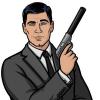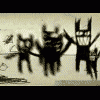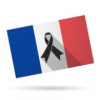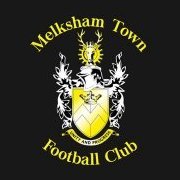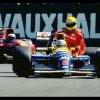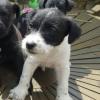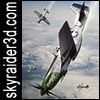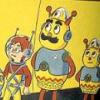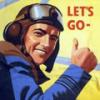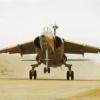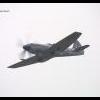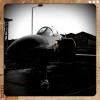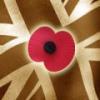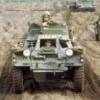Leaderboard
Popular Content
Showing content with the highest reputation on 16/03/13 in all areas
-
Hello friends This is my latest work, one of the most (if not the most) beautiful French aircraft hever! J This is the Hobby Boss kit, with all the good and bad things that we know that we are goint go find when we open the box, in this case they indicate the Gunze 315 color to the fuselage, and as you can check that is wrong (well i saw hundreds of pictures and didn’t saw any with that color), so i went to the internet and with the Gunze 308 as base i made my own color. Some (very) putty is needed to correct some areas (if you guys want i can post some pictures of that latter, just let me know please) the refueling prob is wrong... not the correct shape and the mos annoying thing is the fact of Hobby Boss didn’t include clear parts for the wings light... L In the end with a some work we receive a very nice Rafale on the shelf. I love this one, and i will build other one for sure. I hope you like it Thank you for looking. Best regards from Portugal Vítor Costa4 points
-
This is my Corsair I completed using Humbrol and Modelmaster paints with Sky Decals. The kit is OOB apart from the decals and the antenna wire. I will be adding more images on the Aussie Modeller site when I do the next update.4 points
-
Here is my latest effort, the Trumpeter 1/32 Lightning. I've read about all the shortcomings of this kit, but as it was bought for me as a Xmas present I only added a seat, wheels and decals to the original kit. It LOOKS like a Lightning to me, anyway ! All comments welcomed !3 points
-
Hi All! I just finished my last "Mad Dog" bird in scale 1/144. However it's not a soviet type and not a typical eastern block's bird what I build usually I love this beauty since decades... I hope it can helps to remember for the 90's. Enjoy!... The kit: Minicraft Decal: F-DCAL silk screen series. (i've to say thank you for this perfect quality decal...) ...during building... ...and finally ready to fly...3 points
-
Kit - Hasegawa Mitsubishi F-2B with spine from an Italeri F-16D 'Barak' Paint - Humbrol, Tamiya & Xtracolour enamels, Tamiya acrylics, Alclad II lacquer Decals - Kit & Eagle Strike 'Mirage F-1's part 2' Extras - Damocles pod, MICA missiles & rails from RoG Rafale, etc etc, far too many to mention !!. Communication aerials, RWR nodes, GPS dome all scratchbuilt. Mitsubishi/IAI/Atlas F-2+ 3 Squadron, SAAF, Waterkloof AFB, Gauteng 2016 So, that's that, then. Really enjoyed every minute of this project - except for the couple of days when I thought I'd lost the windshield - great encouragement and participation from so many folks here, but special thanks to Steven Lewis, (FAR148) over on the 'What If site who selflessly responded to a small number of PM's throughout the process and, let's be honest, nailed the camo pattern when I just couldn't see where it had gone wrong. Thanks Steven And before anybody jumps-in, I know the exhaust isn't finished, but I've got an 'Alclad session' scheduled for later in the week !! As ever, happy to take any questions, comments, suggestions and criticism. Next I'll be finishing a Hobbyboss F-14 that I started just before we left the UK, a Rafale http://www.whatifmodelers.com/index.php/topic,36341.0.html and a 'real world' RF-4, before opening up either an F/A-18 or a Eurofighter . As ever thanks for taking the time to look, I'll do my very best to answer any questions, comments and criticism. AFN Ian2 points
-
I've just finished this one which I got from Ashley (Zipper) as a second hand sale at SMW 2012. Nothing new to be said about the kit so i'll bypass all that. This is the first ever one I've done in this scheme and it does look the biz if you ask me. White is appliance white and the red is Revell aqua with the LAG by Xtracrylix. I have used the Xtradecal sheet for some bits and the serial was made up from the bit box. Cockpit is kit with Neomega early seats which are absolutely tip top. The MDC was painted by hand and the canopy T-peices made from stretched sprue and fixed in place. The left over sprue was then used a tool to paint the 6 red discs just behind the front pilots seat as the toothpick was too big. I used a new to me bottle of pro-modellers wash and left it overnight to dry but when I rubbed it off it looked like some of it is a bit sturburn and has stained the paint slightly. I'd like the top side of the wings to be a bit lighter grey but it's not going to happen. It's modelled on an early 80's bird hence the early style FOD guards (made from plasticard) and stretched sprue for the link, old style beacon lights and the crest on the fin. The cabs didn't have the toblerone effect on the leading edges at this stage. The FOD guard handles were made out of the unused etch seat belts and the RBF sleeve is papermache. Thanks to Brian (MODeller) for the help of the crystal light on the nose (I'd ran out!). Anyway the photo's:2 points
-
I think, that this fighter has no needs to be introduced, as it is one of the most known aircrafts in history. Eduard kit of "dreidekker" is a lovely model and "must have" to all WWI-modellers. Mine comes from Dual Combo box, shared with my friend. Kit supplied with a beautiful Eduard-photoetch, consisting of prepainted instruments dials, seatbelts and - the most important - etched details for Spandau-MGs. It is very useful, as plastic guns in the kit are very basic. Unfortunately, I've lost somewhere small etched parts for the breech end, so I borrowed whole breech ends from Roden's Fokker D.VII. Kit is built almost out of the box. As a prototype aircraft of Lt. Werner Steinhauser was chosen. Only two photos of Steinhauser's triplane are known. One shows "funny face" on cowling, "Iron Cross"-type insignias and red fuselage band with yellow cross. And second presents "balkenkreuz" insignia, yellow-red striped tail-plane and fuselage band with inverted colors - yellow band with red cross. I'm completely sure, that these photos represents two different crafts, as the first one shows early small area ailerons on both wings, and second has late-type ailerons. I have decided to mix characteristic details of both aircrafts in one model. So from the first picture I took cowling-face, iron crosses, fuselage band and early ailerons (I think that with these ailerons Dreidekker looks more stylish), from the second picture comes repair patches on starboard middle wing and chipping on olive fields under isignias to the white base. I have added ignition plugs to the motor from stretched sprue and wires to them from nylon wire. It was a little bit lazy for me to hand-paint wooden layers on the plastic airscrew, so I have decided to try make it on original technology. I have glued together five layers of veneer of two different wood types, then I gave it shape with file and sandpaper using plastic airscrew as a sample. Then several layers of clear gloss varnish was given. Paintwork was done with Humbrol enamels. "Rain" camo was brush-painted with diluted olive color over linen base, - I paint parallel strokes with gradually fading apperance, then started again with bold strokes etc. Then strokes was blended a little with white-spirit, then another passage was done the same way. After third passage result seemed acceptable to me. Several coats of Future was given. Oil streaks on lower fuselage and wing imitated with AK-interactive fluid, small amount of MiG pigments added to represent dust on wheels and lower fuselage.2 points
-
Kit - Hobbyboss 1:72 Paint - Tamiya acrylics, Tamiya, Humbrol & Xtracolour enamels. Decals - Kit Extras - None Grumman F-14A Tomcat VF-41 'Black Aces' Photocall, NAS Oceana mid 1978. Not my best build by a long way, but very enjoyable none the less. IMHO a great little kit and well worth every penny. Good points - Price, excellent fit, good detail, you can build it as I have with the wings in the 'oversweep' position (not too many kits give you that option), very good decal choice and superbly packaged. Bad points, very soft plastic reminiscent of old Heller kits, panel lines so fine that they seem to disappear under two coats of paint !! - but that was probably 'user error'. Right from the start I was looking to build it completely 'naked' no pylons, no tanks, all buttoned-up and immaculate - there's a few photos on t'interweb from the Photocall in '78 just before the squadron embarked on USS Nimitz for the first cruise with the brand new F-14's, and they are spotless !! Great wee project, highly recommended. Thanks for taking the time to look, as ever all comments, criticism, questions and suggestions are welcome. AFN Ian2 points
-
Hi Guys Here is a model which has been in the part built box for a while and has now finally made it to the finish line. The basic airframe was built by Tony H a few years ago but was passed on to me as a part built S5. The plan was to finish her as WK198 since I had already built a Swift for my collection of 1950's fighters but this would fit in the record breakers collection since its feats in the Libian desert. Thinking this was easy I gave her a coat of blue, did the last bits of assembly and job done. Only then did I realise that as a Mk 1 converted to a Mk4, WK198 didn't have the extended chord outer wing, had a shorter fin and a slighly different shape under the nose. Hmmmm Well after a year or so I plucked up courage to cut her up and made the 3 mods above. Cutting up a vacform is not quite as easy as a normal kit but I was able to feed some rod into the the new leading edge and reattach/blend the wings to it by using lots of super glue and Milliput. I also made a new undercarriage having lost the original in a house move. (I know its here somewhere!) I stripped off the decals before repainting and making some new ones. Finally I added the wing fences. A note in Brians book 'Swift Justice' says these were removed for the record flight but I'm not so sure. Anyway at long last here are 2 Falcon Swifts, a rare sight if ever there was one! Cheers Colin W2 points
-
2 points
-
This is the best looking(in my opinion) form the 65th Aggressor Squadron. The camo turned out great in the end and I am very pleased with the results. I used aries cockpit and exhaust, Eduard exterior detail set, and Two Bobs decals. Hope you enjoy. Thanks for looking.2 points
-
Big push and some solid effort and I'm calling her done. Thought I'd finished about 5 times and kept finding bits I'd missed, in fact I still haven't finished the anchors. Proper photos tomorrow in RFI. Thanks for looking Nick2 points
-
A good kit that lefts plenty of space to an advanced modeler. Cockpit was enhanced by scratchbuilding and flaps were cut off and repositioned slightly and radiator grill was added, as well as cut outs in the wheel wells. I really did my homework on this kit and care was taken to simulate the difference between wooden and metal parts. As it operated in defensive mode I took some liberty to cammouflage it a bit further by painting gear covers black, as well as the area behind the seat and fuselage sides. Sorry for the crappy pictures. Josip2 points
-
Hi folks. Got these two finished today. First up Trumpeters Seafang, the kit fits together really nicely, I know there are accuracy issues but this was a simple OOB build; Then the Airfix Seafire FR46, still a really nice kit which looks great built up. Used an Aeroclub prop; Hope you like them.2 points
-
2 points
-
Hi all well this is my first post of the year I have been busy with a kit I have become particularly fond of and I have been looking forward to sharing these with you. I really would have liked to get some natural light shots but unfortunately I've had to resort to flash photography which I'm not keen on so maybe some better photos later should anyone like to see them. XH558 1992 scheme I tried very hard to get the cammo pattern right on this or as near too I tried to recreate her as I remember her when I was a kid and made up various decals for the entrance door script and large ejection seat triangles she used to carry I also extended the tail pipes. XM650 B2 a citadel wash was used for the panel lines XM605 giant voice markings citadel wash XM575 VX777 This one took 4 weeks to modify. the tail cone is wet finger shaped out of milliput using the supplied blue steel missile as a core and the tail extended using the spare supplied tail. the engine exausts were made out of airfix vc10 axle mountings. the air intakes were left as per kit. and the wings simply filled down to shape. the various parts removed from the engine tunnels and skybolt hardpoint plate plate removed. with XL321 from last year and with XH533 which i modded the rear to the type 2 cone last year and XL321 Group shots with others and a painted and restored wiking b1 xa906 Thanks very much for viewing look forward to your thoughts.1 point
-
Good afternoon Here is my latest model built the Sea Fury flown by Flt CARMICHAEL in which he downed a MIG 15 .. I used Eduard PE to detail the cockpit ,I also replaced the propeller by a Pavla one I used Humbrol paints .. Uploaded with ImageShack.us Uploaded with ImageShack.us Uploaded with ImageShack.us Uploaded with ImageShack.us Patrice1 point
-
Hello Everyone: This is my first post here, my first Russian plane in 48th and my first Flanker! I have done what a I could to take better pictures, as it was to resplendent I changed the gloss finish to semi-gloss and I added a picture of the conversion I used. It is a conversion I found on ebay time ago, does not have any brand on it (or box... or bag...), i guess is the copy of a copy... of a good conversion. Interior, seat, windscreen and IR were not included so I used some parts from the academy kit, seat from wolfpack and scratch for the windscreen and IR. Decals from begemont, demo flankers and PE ladder from Turbine. It was painted with water based acrylics, Akan for the interior and the dark brown, Vallejo for all the rest, including primer, varnish and decal solution (first time working with this kind of paint and I loved them, no smells, no thinners, just tap water!). I tried to build a model of the first prototype, as it was seen in FIDAE 98 in Chile. I have just started to work on Flankers and I`m not an expert so would be great to have some feedback. All comments and constructive criticism welcome. Thanks for watching. Adrian1 point
-
Hi all Here is my entry for the F-15 GB, the rather nice Tamiya F-15A. She is built with Eduard etch interior to replace the kit decals which were shot, a Quickboost bang seat and Two Bobs decals (which were great). She is built as 76-033, `25th Fighter Wing, Florida ANG, July 2006 The weapons are the kit's and she is painted in Xtracrylix for the main paint, Alcald Steel for the rear and Mr Metal for the exhaust. Thanks for looking and all comments welcome1 point
-
Here are some pictures of my model of the Russian Navy's flight deck tractor from the Admiral Kuznetsov. This type of tractor was specially designed for towing aircraft on Soviet Navy carriers. They entered service with the Kiev class heavy aircraft-carrying cruisers in mid 1970s and later continued to serve on the Admiral Kuznetsov, where several vehicles have been in use up to the recent years. Very few of these tractors were produced, and most of them underwent some form of customization or upgrade at some point of their service life. This resulted in a variety of wheel and tyre types, driver's position and external lighting arrangements seen on different vehicles. My kit is manufactured by F4Models (cat. # 7003). I used thin wire to model the seat frame, some braces and drawbar pins. Side lights, rear lights and a warning beacon are molded in resin in the kit; I have fashioned the beacon from clear plastic instead and took the aftermarket headlights produced by Elf. Painting and finishing is fairly straightforward: first Vallejo acrylic paint, then gloss varnish and some neutral wash and finally Vallejo matt varnish. The kit's configuration and markings correspond to a tractor from the Admiral Kuznetsov as seen in mid-2000s.1 point
-
1 point
-
The Bristol M1.C is not such a well known aircraft from the Fisrt World War, as it was largely restricted to use in the Middle East and with training units, due to monoplanes being out of favour at the time it appeared. It is a shame as it was by all accounts a superb aeroplane, designed for speed and handling and was very well liked by those who flew it. Rarely kitted, Alley Cat have come up with a beautiful 1:32 model of Bristol's M1.C cast almost entirely in resin. Even in the box it looked impressive, a full review is Here. It built as good as it looked, being an absolute pleasure from start to finish. One of the most difficult things to do was choose one of the 7 colour schemes provided, because I really wanted to do three of them (72 Sqn or Silver & black trainer or 150 Sqn). In the end I went with the 72 Squadron machine as I have a slight preference for front line machines. There is a 'Work in Progress' Here describing the build. Anyway, enough talk, here she is; Now I'm sure that this model is going to appeal especially to those of us who also build Wingnut Wings WW1 kits. So I couldn't resist a couple of pictures with it alongside my WNW Bristol F2.b. In conclusion I would say that this is an outstanding first venture into World War 1 kits by Alley Cat. The quality of the resin castings is worth special mention as they are absolutely superb. This was the single piece fuselage before I started; It would make a very good first resin kit, (apart from a disasterous ARBA TSR.2 twenty odd years ago this was my first full resin build), and the rigging is very simple I hope Alley Cat continue with this series, and eagerly await the next release, whatever it will be. Can I start the suggestions rolling with a Fokker D.VIII? Please! (Eduard 1/48 Weekend edition) Cheers John1 point
-
Some facts from Great History: Despite the fact that some sources show this plane with the serial number LN853 (as well as on the decal from Italeri), in fact, this number had Spitfire EN853, because LN853 number was reserved for a series of "Wellington" heavy bombers. EN853 board was placed in the Royal Air Force in May 1942, in the 401st flight squadrons. In August 1942, the unit was transferred to duty in the 121st Squadron RAF "Eagle" in Rockford, formed from American volunteer pilots. On the September 24th, 1942 in order replenishment squadron arrived American volunteers, among whom was Major William "Jimmy" Daley - an American, a native from Amarillo city, Texas. And he gave this aircraft. It is noteworthy that William Daley on arrival assumed command link - three days after the death of its namesake and countryman - Lieutenant William Kelly, nicknamed "Wild Bill" – who was a former bus driver. In September 1942 the 121st Squadron of the Royal Air Force was disbanded, and on this basis has been created 335th Fighter Squadron, which was a part of the Fourth Fighter Group U.S. Eighth Air Force (USAAF's Eight Air Force). Then, apparently, over the UK ID marks were bears the U.S. Air Force and the letter codes are unchanged. In January 1943, W.Daley was called back to the U.S., as a pilot with combat experience, to work as a flight instructor. During this short period (just over two months) W.Daley managed to knock on this Spitfire 2 and 3 damage to enemy aircraft. At that time, the squadron was primarily to track the B-17 and B-24 bombers. In the same month, the EN853 board received the large amount of total damage during the intense fighting, and then this aircraft was scrapped for parts. In 1944, former pilot of this board - Major W.Daley returned to Europe, but in the 371st squadron of the U.S. Air Force, where he was to fly in heavy fighters P-47 "Thunderbolt", but, unfortunately, was shot down in combat and died in September 1944, just after the Allied landing in France. About model: This model of Spitfire from “Italeri” has some difficult to fix geometry, in particular, playing the infamous W-shaped profile of the wing. There are also minor defects as "no-cutting" jointing lines and hatches. I tried to fix something, something too lazy. The fuselage of the model, for the sake of cost reduction in the production of various modifications, is made from five parts. But fitting of parts is tolerant, except for the "classic" docking wing to the fuselage. I did not use any aftermarket. I graved thickness of the wing from the inside to cut 6 holes to clear sleeves. The main cannon made from a 0.3 mm brass profile. They wound copper wire of 0.1 mm, trying to imitate the trunk lining. Guns are also made from a tube, setting them flush with the edge of the wing. Belts in the cockpit and instrument panel – decals from tamiya’s Spitfire. Mirror re-manufactured from a piece of brass wire and Christmas tinsel. Basic colors - Tamiya acrylics, gloss - Future and matt varnish from Tikurilla. Made of copper wire on the landing gear hydraulics. Piston rod - Chrome Silver from MM. Exhaust pipes drilled, painted with “rust” Revell 83. Antenna cables - Nylon thread. Welded decals with "Set" and "Sol" from Microscale. Chips - part of a toothpick in the fresh scratch acrylic, some wearing makeup brush #000. Soot from exhaust pipes - Tamiya powder box, washing-MIG, and drips - Tamiya Smoke X19. I was used in this works many materials from "walkaround"s, "Kagero", "Squadron", "Aero Detail", "Osprey", "Warpaint", "War in the Air," etc. magazines and some www information.1 point
-
Looking forward to this one Tom! Was great talking today bud, c u tomorrow1 point
-
C1/C3 what? Are you talking about C-130s? If so, yes, the blades are natural metal colored (**not** shiny at all - they look more grey from anything more than inches away)1 point
-
A quick update... I airbrushed Humbrol 27 as the main colour to virtually everything except the the Soyuz 'nose'. The exhaust bells and bases and the bottom parts of the booster rockets were painted Tamiya Silver and then used my Flag Red mix to paint the insides Then detail painting to the Vostok capsule - I think I may have to redo this as the bottom (with the ring) should be Humbrol 27? I used a photo of one in a museum and it showed Light Grey - I will go away and check again. Matt Irvine's article said that the oxy bottles would have been green, so that is what I painted them. Finally the Soyuz capsule/nose in Flat White with red-topped fluting at the top Once I have confirmed the colour of the lower part of the Vostok, I can start getting it all together. I have also primed and painted the base satin black. The last thing is to paint Yuri - I'll try and get him done tonight. Thanks for looking1 point
-
1 point
-
Todays work is the cleanup of the fuselage joints, preparation of the forward turret recess for remodelling to a more accurate shape and the test fit of the wings. The tailplane and fin have been fixed the only thing to remember is that reducing the thickness of these surfaces requires the attachment point to be thinned accordingly. This is easily achieved with an emery board before these parts are fitted. Surprisingly the kit canopy looks ok as this is a recent mould when compared to an old original which is truly awful. Therefore I will keep the kit one and just polish and future it as usual. Next will be a wash in luke warm water with a splash of washing up liquid to get rid of the accumulated dust inside and out followed by a primer coat to show up imperfections and then re-scribing of the fuselage. Till the next. Mike .1 point
-
MK4 SPITFIRE by 1943 it was obvious that war with germany was at the very least quite likely. the main fighter/interceptor in raf service was the mk2 spitfire with a 1600 hp merlin engine with 2x20mm cannons and 2x .50 cal mgs. the new mk3 spitfire with 4 cannons and a new more powerfull griffon engine were beggining to enter service but it was felt that someting more extreme was needed to combat the rumoured jets that tha allies thought germany were developing. the gloster meteor wasnt progressing as quickly as hoped and a stop gap was proposed to keep pace with these wonderweapons. the supermarine design team decided to put to new griffon 64 engines (2350 hp each) into a spitfire inline this gave over 3 times the power of the mk2 variant with no noticable increase in drag this resulted in superb performance with an astounding top speed of 560 mph (which was even faster than most of the german jets!). coupled with 4 hispano cannon this interceptor version went on to serve well into the jet age on equal footing1 point
-
Thanks very much for your kind comments! Much appreciated! Yes drawings are always an issue. The beauty of 3D is that you can match up the model not only with 2D planviews but also with perspective photographs. It's very fiddly but it brings to light many interesting errors on drawings. I first discovered this doing my Mustang in 2004... so many drawings suffered from the same problem (a too short rear fuselage, if I recall correctly). Doing it in 3D is a fresh approach. I can't guarantee it's error free, but generally a lot more accurate for sure. I'll produce line drawings of my model once complete.1 point
-
I cant believe you are getting all upset about a few letters not being capitalised? Always remember the guys making these kits are in China and they might not realise the difference? Julien1 point
-
Oooh, wing & fusleage tanks, Sparrows & Sidewinders. The FAA Phantoims were pretty much comitted to AD full time so although they were capable of carrying bombs & RN pods they are seldom seen. HTH1 point
-
I seem to remember an account in which Spitfires supposedly 'rescued' two untroubled Whirlwinds from a group of Fw190s. The Whirlwind was an agile plane and would have certainly made mincemeat of the Bf110. The Bf109 was more problematic - the Hurricane could out-turn it but was otherwise outclassed. However, the four Hispano cannon layout in the Whirlwind would have been a deciding factor. That kind of firepower would allow the Whirlwind to hit at ranges greater than the Luftwaffe bombers could handle. As the original poster is envisaging a lot of Whirlwinds any reliability problems with the Hispano would have been rapidly solved. I suspect that the RAF would have evolved tactics to use the good points of their fighters. The outcome of the BoB would have been the same though.1 point
-
Franks conversion wasn't without its faults. He made the mistake of widening the fuselage to accommodate the wider Speys. Consequently the wing span is wrong on his model - its too wide (and yes I have discussed this with him on LSP many eons ago.). Best way of describing this is to imagine that the Speys were closer together than the J79's and lower in the fuselage. The rear missile recesses for example are in the same place - only angled down at the rear. The wing flaps are in the same place and are of the same size - except the small fuselage fairing on the F4J fuselage is not there, thats how wider the rear fuselage is there. The inner flaps on the K&M fit flush to the fuselage. At the front end the wider intakes extend the fuselage out by a few inches only. The mid- fuselage width - is the same on the J,K & M . The V-shaped heat panels below the tail are narrower on the K&M. than on the J. I've come to these conclusions over many years, of studying photo's, books and primarily by comparing Hasegawa's F4J and FGR2 kits. These are accuaret enough for my purposes, and even scaled up should provide a sufficiently accurate model. Biggest problems I will have is how to mould a couple of Spey cans...the rest of the conversion should be relatively easy............. In fact I think I may dig the spare Tamiya F4J out of the loft very soon.....................1 point
-
Hello all, Full WIP can be found here: http://z15.invisionfree.com/72nd_Aircraft/...?showtopic=2258 But in the mean time here are some images of the completed model. Many thanks. Adrian.1 point
-
A little outside the scope of this thread, but IIRC a wargaming session/study was held in the 50's or 60's with participation of former German and British generals and admirals from WWII. The purpose was to study whether or not Operation "Seelöwe", according to the original German plan, could have succeeded. One of the contitions set before the game was that the Luftwaffe had won the BoB. But in the end the operation failed, because even if the German Army had succeded in getting ashore and captured a bridgehead, Germany wasn't able to provide enough supply across the Chanel to sustain a ground offensive in England. They had no Mulberry harbours, no PLUTO, no Red Ball Express and they were woefully short of ships to provide the large scale uninterupted logistic flow needed. As a comparison the Allied supply capacity across the Channel in 1944 was vastly greater than anything the Germans would have been able to achieve in 1940, but even despite this, it was still a severely limiting factor for the operations on the western front in 1944.1 point
-
The effect of the oil canning is less visible because of the matte paint finish, in order to compensate this i highlighted each panel with my airbrush. Please don`t mind the different color tones in the pictures, they were taken with different light/camera settings. Karel1 point
-
1 point
-
1 point
-
Cool! A new British Jag to be released in the month of my birthday. I'm going to pretend the date was set to coincide on purpose1 point
-
Is this thread really going anywhere now? I've been watching the "Yes they will", "No they won't" argument go back & forth (very politely so far) for several pages now, and haven't seen much if any new material of late. Could we just round it up by stating that some people think it'll happen, and some don't, and agree to differ? Then we can all go off and abuse electrons on another thread with a hopefully more productive outcome. Just so long as it's not arguing over colours on a black and white photo, or some such malarkey Oh, and just to add... I hope they do, and I hope it sells well, but I won't hold my breath1 point
-
Maybe- is that a set of plans he's being handed? I guess that would make the one on the right RJ, though it looks more like the Disney heroic version thereof (and angelic, too!) bob1 point
-
1 point
-
I've done a bit of work on the floor and firewall. I had to scratch build a few parts such as sill infill panels, firewall ends firewall cross braces, the whole battery (the one in the kit is rubbish - it's shaped like a pyramid!) the brake vacuum tank and pipework. I've also started to add wiring and bits of plumbing according to various E-Type books and diagrams I have. I was going to convert the car to the 'proper' right-hand drive, but then realised the Group 44 cars were all lefties so I'll leave well alone. Front suspension and engine installation next....... Roy.1 point
-
So close to finishing now. Fun with string, a few more railings and we're done! Thanks for looking and your continuing support. Nick1 point
-
After a month of inactivity due to everything else needed to be done.. some progress. The Italeri exhausts weathered.. The fan installed and some masking started with some kabuki tape.. fixed the Italeri exhausts.. not a perfect fit for Sierra Hotel Models intakes.. to have a little more flesh to sand things smooth later.. just a little filler required..1 point
-
1 point
-
1 point
-
1 point
-
Pretty much normal practice. Let the Klear cure for a day or so for absolute best results. The stuff is actually floor polish and designed to be walked on once dry.1 point
This leaderboard is set to London/GMT+01:00

